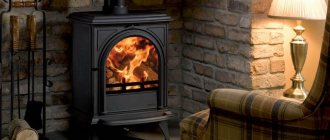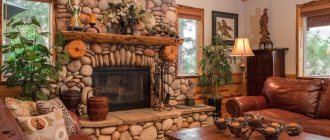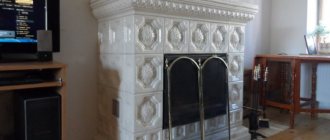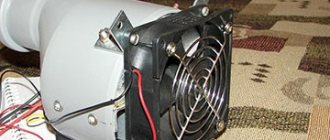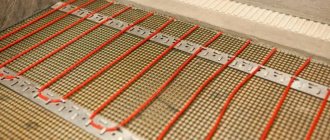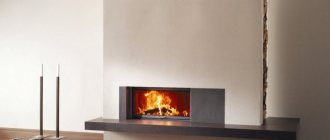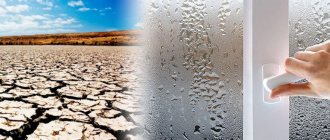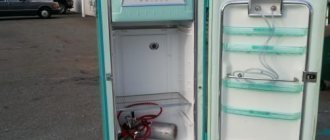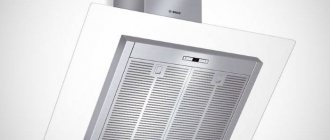Principle of operation
In society, fireplaces are associated with aristocratic premises and rich interiors. Therefore, many people believe that heating with a fireplace is too expensive and unusual for their social class. However, a small wood-burning fireplace can warm up a small apartment in a matter of minutes.
Fireplace with air circuit
Modern research has shown that the heating efficiency of conventional stoves can be increased several times by organizing a convection heat transfer scheme. The convection scheme for heating a room uses the physical laws of our world, that is, warm air emanating from the pipes will rise and heat the room.
The main heating equipment in the firebox is the liner in which the air is heated. The liner is surrounded by air pipes. The pipes are connected to the pipe system for air distribution. The air is moved by fans.
It should be noted that air-heated heating equipment can move hot air due to a gravitational system that uses closed ventilation ducts. In such a system, air movement is ensured by the temperature difference between the gases. The gravity system is very demanding on the placement of pipes - the number of turns should be minimal.
Fireplace air ducts
In order for heating fireplaces to efficiently heat the entire room, each room must have a ventilation hole with a grille. To heat the room from all sides, anemostats or closed diffusers are often built into the ceiling.
This heating system is not suitable for heating a ventilated room. That is, the pipes are not routed to the kitchen, bathroom or dressing room. If this recommendation is ignored, an atmosphere with disturbed air pressure will be created in the apartment. In conditions of impaired air pressure, unpleasant odors do not leave the kitchen, but remain in it.
Also, gas fireplaces with an air heating system are not recommended for installation in rooms where there are large windows or doors with poor sealing. It is worth noting that sealing can be improved with your own hands using modern building materials. Then air fireplace heating will be able to spread to these rooms at the risk of being drawn into the atmosphere.
Rules to follow during installation
There are not so many of these rules, but failure to comply with them can lead not only to ineffective operation of the fireplace, but also to other more dangerous consequences.
- The main fan must be selected and installed so that its noise does not interfere with comfort.
- For the same reason, the air duct pipes must be of round cross-section.
- The convection chamber must be made of galvanized iron and lined with plasterboard.
- It is impossible to include in the air heating system rooms in which autonomous ventilation is provided. Kitchen, bathroom. Counter currents can disrupt proper air circulation, which will lead to bad consequences in the form of unpleasant odors and high humidity.
- To ensure fire safety, it is necessary to construct a heat cutoff from the ceiling.
These nuances simply must be observed.
Advantages of this type of heating
Let's consider the efficiency of savings and stability of the air system:
- Reduce costs by 10-20%. An air-heated fireplace continues to function for some time after extinguishing due to circulating hot air in the pipes. Even after extinguishing, the heating system continues to heat a private home;
- Using hot smoke. The temperature of the smoke escaping into the atmosphere is 170-200 degrees. So why not use this gas as an additional heat source to warm the room? Such fireplaces are equipped with a special air duct for circulating hot smoke;
Air heating operation diagram [ads-mob-1][ads-pc-1]
Ventilation and heating
The considered advantages of air heating speak eloquently about the effectiveness of such a heating system. Ducted heating systems boast three heating methods:
- Convection. By mixing cold and hot air;
- Heat transfer. The walls of the house are well heated by hot air;
- By radiation. The heat comes from the open fireplace insert.
Such a complex heating system can only be installed during the construction of a new house. It is quite difficult to install such a system with your own hands. Its installation requires an excellent understanding of drawings, significant costs for pipe materials, adapters and sealing agents. In addition, it is better to entrust the installation of the ventilation system to a specialist, whose work, of course, is paid.
Features of the stove device
Firebrick Dimensions
It has been proven above that air circulation is much more efficient than traditional fireplace heating. High efficiency indicators are maintained due to the special design of the stove. It is worth noting that gas fireplaces are not much different in the design of stoves.
A cassette fireplace is the most demanding design for the correct arrangement of the stove. To equip it, builders use only refractory bricks or metal structures made of cast iron.
Cast iron stoves are considered the most heat-intensive and efficient heating devices.
Fans are located above the stove. Practice has shown that heating a house with a fireplace depends on their reliability. Therefore, experts recommend choosing only fire-resistant fans if you plan to install them yourself.
As for decorative elements, their presence is optional for a private home. However, summer residents are actively buying fireboxes with decorative elements with glass doors, modern opening mechanisms, etc. When choosing a stove for a fireplace in a country house, special attention should be paid to the power of the device, which can be determined in the technical data sheet. The power of the stove increases with its size.
Experts have come to the conclusion that it is better to buy stoves 10-15% more powerful than the equipment requires.
Diagram of air heating in the fireplace
Separately, it is necessary to note the closed stove. The lockable design further increases the power of the entire structure due to the smoldering provided by the closed door. As a result, not only the power of the equipment increases, but also the savings in fuel consumption increases due to a decrease in air supply. Thus, a closed firebox is an effective and economical equipment for heating a room.
Self-installation
It should be immediately noted that all the work involved in organizing the construction of a fireplace with an air duct with your own hands is quite labor-intensive. In addition, the process is divided into stages, each of which has its own theoretical justification.
However, this does not mean that it is impossible to independently arrange such a fireplace. If you have ready-made projects and the necessary drawings, you can complete the entire installation efficiently and without significant errors, even with minimal experience in the furnace business.
Many professionals willingly share their experiences. It is recommended to use proven ideas from experienced craftsmen. A ready-made installation diagram for a corner air-heating fireplace will help the novice master at every stage, starting with laying the body itself.
Brick fireplace diagram
Choosing a location for the fireplace
The first preparatory stage is accompanied by the choice of installation location for the future fireplace. Despite the fact that there are many design options, in this case you will have to be guided solely by the practicality of the solution.
For high-quality heating of a house with a fireplace, it is necessary not only to provide the rooms with an air duct system, but also to optimize the length of the ducts. The shorter the length, the better the circulation will be. Therefore, the fireplace must be installed in a corner to utilize the maximum number of rooms.
In large houses it will not be possible to warm up all the rooms, and you will have to put up with this. But in standard layouts you can always find a room that borders on the maximum number of other rooms.
Convenient corner location
Construction of the foundation
In terms of weight, a fireplace with convection heating is practically no different from a classic fireplace. The foundation construction stage will also be similar. A pit is dug so that its depth is 60-70 cm. Depending on the chosen project, fireplaces can have a podium or a rectangular body, like English styles. This will affect the area of the foundation. Its boundaries should be several centimeters larger than the dimensions of the fireplace.
To fill the foundation you will need sand and crushed stone. But sometimes the pit is filled with concrete blocks. All this creates a reliable support for the fireplace. As a solution, you should use a masonry composition in a 1:4 ratio of cement and sand. The height of the foundation must correspond to the level of the floor covering. All other construction work must be suspended for the mortar to completely harden.
Wall masonry
Having made a layer of roofing felt on the foundation, you can begin laying the fireplace itself. To take into account the presence of all components and heater channels through which air will pass, the masonry should be carried out in separate rows according to a strictly defined pattern. This principle does not depend on work experience. Even professionals carry out similar actions with the difference that they remember many schemes by heart.
Direct construction of the fireplace
Some fireplace options include a brick firebox. But there are popular models in which a metal firebox in the form of a cassette is built into a brick portal. Measurements show that options with metal fireboxes have slightly higher efficiency than those with brick ones. However, the difference is so insignificant that everyone chooses the appropriate execution based on their own ability to pay.
Air duct installation
In the place where the air ducts pass through the walls of the room, the air temperature is not as high as in the firebox. But it is still necessary to provide for safety conditions. The contact points between the air duct and the finishing materials of the walls are insulated with mineral wool.
The main line itself is made of brick when building a house or from a flexible metal pipe. The master’s task is to thermally insulate this line so that the air retains energy for as long as possible during transportation. You can hide the air duct using a plasterboard box. To do this, a frame is made of a metal profile and sheathed with sheets of heat-resistant plasterboard. In some cases, air ducts are made inside the wall.
A well-installed heating system allows you to effectively heat the entire house using a fireplace, thus combining decorative qualities and technical capabilities.
Mistakes when choosing an air-heated fireplace
The generally accepted scheme for selecting heating equipment is unacceptable in this case. Most believe that the power of the firebox is adjusted to the area of the room at the rate of 1 kW per 10 m2. Time has shown that choosing a firebox for fireplaces for a country house with air heating requires an integrated approach.
Gas stoves that are too powerful lead to overheating of the apartment. Residents have to open windows or reduce the amount of heating fuel they use. Frequent temperature fluctuations provoke colds and other unpleasant symptoms - weakness, dizziness and insomnia.
Fireplace area calculation table
How to calculate the required firebox power for an air-heated fireplace? Experts advise contacting sales consultants with this question. It is necessary to contact a specialist correctly, that is, by providing information on the area of the room, type of ventilation and number of rooms. Only in this case will the seller select the required power of the equipment.
Fireplace performance characteristics
Depending on the duration of heating, fireplaces are divided into two categories. As an indicator, the time during which it is able to maintain the desired combustion mode with one load of firewood into the firebox is taken into account. The heater will correspond to the intermittent burning category if one plug lasts for 6–8 hours.
If from one tab it can work for more than eight hours, then it can already be classified as a source of prolonged combustion. The operation of fireplaces is characterized by three main intensity modes. To heat up, use the maximum power mode, in which the wood burns very quickly (up to four kilograms per hour). In this case, the damper regulating the air supply is opened completely. Rated power mode – within 10–18 kW. In this case, the firebox damper is opened halfway.
Heating diagram for a house with a fireplace
